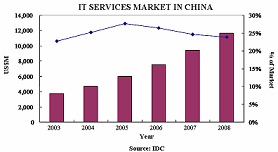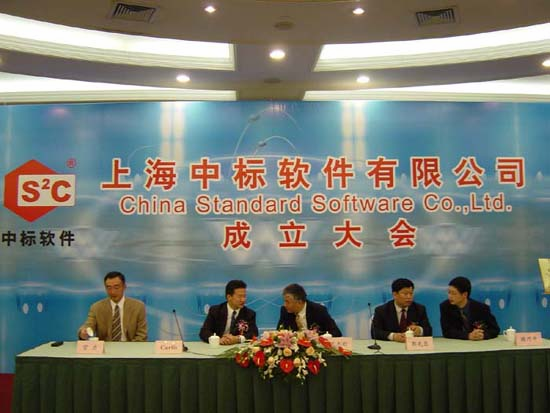|
China.
China
.
China
. We can’t seem to go
through a single day without hearing about the new economic
frontier in the East. From giant multi-billion dollar
corporations to entrepreneurial outfits in
Silicon Valley
, they all want a slice of
the profit pie.
China
’s put the “C” back in
the big proverbial Cheese!
Background
 The
world’s greatest industrial revolution is taking place in
the shortest possible time in our lifetimes, and will never
be repeated. McKinsey
& Co.’s worldwide managing director Ian Davis, in a
conversation with Fortune Magazine, says that for Fortune
500 CEOs China is “Absolutely center stage.”
Goldman Sachs predicts that
China
’s economy will overtake
the
US
by 2039.
A staggering amount of wealth is being created in
every sphere, and it is key for Indian entrepreneurs to
recognize this gold rush and try to exploit it.
IT companies should ignore this at their own peril. The
world’s greatest industrial revolution is taking place in
the shortest possible time in our lifetimes, and will never
be repeated. McKinsey
& Co.’s worldwide managing director Ian Davis, in a
conversation with Fortune Magazine, says that for Fortune
500 CEOs China is “Absolutely center stage.”
Goldman Sachs predicts that
China
’s economy will overtake
the
US
by 2039.
A staggering amount of wealth is being created in
every sphere, and it is key for Indian entrepreneurs to
recognize this gold rush and try to exploit it.
IT companies should ignore this at their own peril.
China
is however a very different
marketplace, and plays by different sets of rules that
require keen understanding and appreciation of local
business and cultural issues. The next five years will
provide tremendous opportunities for committed firms to
build the market share, profit from local ventures, and
acquire skills required to face the expected onslaught of
competition in the global marketplace from China-bred
firms.
India’s Opportunity: Play in The World’s
Second Largest IT Market is the Opportunity
The
size of the domestic IT market in
China
in 2001 was US$30 billion.
The hardware sector takes the lion share of 80% and the rest
20% is made up of software and services. According to the
Tenth Five-Year plan, the Chinese Government will invest Rmb
500 billion (US$60 billion) in IT sector.
It is hoped that the contribution of IT sector to GDP
will reach 7% in 2005. This is in line with government
forecasts that
China
will become the second
largest IT market after the
United States
in 5 years.
The
Chinese appear to be first targeting local markets, gaining
the experience and confidence in developing and servicing
markets, and then using this as a springboard to compete in
the world market. It is to be noted that there is already
some groundswell of activity wherein Chinese returnees from
United States
and
Europe
are getting into the act of
bringing offshore work to
China
. Their attempts are aimed
explicitly at mimicking Indian firms’ models for success
in IT offshoring. As an inducement to promote IT, local and
central governments in
China
provide preferential
policies that provide office space, facilities, tax
incentives and reduced paperwork specifically for overseas
Chinese who can bring technology to
China
.
WHY I.T. WILL EXPLODE IN CHINA ?
 The
Chinese IT market is growing by leaps and bounds prodded on
by market forces combined with active encouragement and
inducements by central and local governments. The
Chinese IT market is growing by leaps and bounds prodded on
by market forces combined with active encouragement and
inducements by central and local governments.
With
its dominance in manufacturing assured
China
now realizes that expertise
in IT is critical in order to sustain the current growth
levels. Without self-sufficiency in IT markets,
China
realizes it is going to be
far more difficult to compete or be taken seriously in world
markets. This appears to be the unstated driver of
Beijing
’s technocrats.
There
are of course barriers to implementing this vision. Western
companies don’t think
China
has proven its mettle in
software development. It
is primitive compared to the West and
India
.
There is also a lack of world-class level mid-to-high
level IT professionals, a fear about IP being stolen, and
the regular linguistic / cultural barriers.
The Chinese government recognizes that these issues
exist, and if the past is any indication, they will
effectively address this quickly.
 There
is also substantial spending in IT for the Beijing Olympics
in 2008, as well as significant development in the financial
services industry. The Chinese government is also focused on
a major initiative to promote Linux and other open source
technologies. There
is also substantial spending in IT for the Beijing Olympics
in 2008, as well as significant development in the financial
services industry. The Chinese government is also focused on
a major initiative to promote Linux and other open source
technologies.
The rich and vast
manufacturing sector of
China
has realized that IT is
going to become a competitive advantage in the years to
come.
 The
Japanese IT Services market is estimated to grow to US$15
billion by 2005. Even though the Japanese are latecomers to
the Offshoring bandwagon, they are determined to make up for
lost time. Many of the Japanese IT firms such as NEC and
Hitachi
already have significant
presence in
China
. The CIO of a prestigious
Japanese Consumer Electronics and IT company opined that in
five years time China is going to narrow the software
process maturity gap with India. The Japanese clients have
already made up their mind that their offshoring destination
is going to be
China
. The
Japanese IT Services market is estimated to grow to US$15
billion by 2005. Even though the Japanese are latecomers to
the Offshoring bandwagon, they are determined to make up for
lost time. Many of the Japanese IT firms such as NEC and
Hitachi
already have significant
presence in
China
. The CIO of a prestigious
Japanese Consumer Electronics and IT company opined that in
five years time China is going to narrow the software
process maturity gap with India. The Japanese clients have
already made up their mind that their offshoring destination
is going to be
China
.
The
rich and vast manufacturing sector of China has realized
that IT is going to become a competitive advantage in the
years to come.
Should India
Worry ?
India
continues to believe that
the language barrier will make it harder for
China
to work with
English-speaking customers. The biggest barrier is language
which is being effectively addressed. English has become
mandatory learning in Chinese schools.
Students in high schools and universities are being
told to put their energies to learn English skills rather
than Chinese. Even while traveling in the interior
provinces, this commitment can be seen in action. Most
places now boast both Chinese and English billboards. In
four visits to
China
since 1997, I noticed a
gradual improvement in the English speaking and
understanding level in Chinese people.
The other thing that
Indian companies say is that Chinese companies don’t have
the same adherence to international software standards. The
Chinese are excellent students, and have demonstrated the
ability to take complex processes in manufacturing, copy
them, refine them and then to improve on them, in a very
short span of time. The
Chinese will quickly master software development processes
such as CMM, and provide leadership and innovation in that
space. In my role of managing the subsidiary of a major IT
multinational in
China
, I have experienced
first-hand an all-Chinese workforce in
China
. A Fortune 50 Client
recently confided to me that my Chinese Team has outdone the
equivalent Indian Team with their dedication, hard work and
promptness in spite of the language weakness in English.
Chinese are fast learners with regard to processes and
technologies.
India
should be worried.
China
may end up leading the
charge in creation of real products as well. If the
innovations coming out of the Chinese-run Microsoft R&D
Center in
Beijing
are any indication,
China
will rapidly surpass
India
in being recognized as
world-leading, innovative software research center.
 By
it sheer size,
China
is going to be a breeding
ground for some world-class local players.
It is therefore very critical for an aspiring global
player to play in this competitive market. An Indian company
who hasn’t learnt to live and thrive in this cut-throat
environment will soon see its core-advantages vanish pretty
quickly amidst the onslaught of the Dragons. By
it sheer size,
China
is going to be a breeding
ground for some world-class local players.
It is therefore very critical for an aspiring global
player to play in this competitive market. An Indian company
who hasn’t learnt to live and thrive in this cut-throat
environment will soon see its core-advantages vanish pretty
quickly amidst the onslaught of the Dragons.
Currently, the local and
central governments are throwing a welcome mat for foreign
IT firms, especially for Indian IT firms. It is quid-pro-quo
arrangement.
China
wants to give access to its
local markets for Indian IT firms, but it also wants to
learn from Indian firms. A few years from now it is quite
conceivable that the Indian IT firms will have to compete
with the same firms/people they trained. It is to be noted
that with or without the help of Indian IT firms,
China
is certain to develop a
robust IT industry that can challenge the built-in cost
advantages and service efficiencies that Indian IT firms
currently enjoy. To
learn to compete against these players inside and outside
China
, Indian companies need to be
in
China
now.
By it sheer size, China
is going to be a breeding ground for some world-class
local players. It is therefore very critical for an
aspiring global player to play in this competitive
market. An Indian company who hasn’t learnt to live and
thrive in this cut-throat environment will soon see its
core-advantages vanish pretty quickly amidst the
onslaught of the Dragons.
Strategies for Indian Companies
The
question is – should one set up in
China
today to focus on the domestic business, or should one
set up a center to focus on
Japan
. It’s going to be difficult to do both at least
initially. We
examine the options.
Establish a full-scale solutions delivery
center in China for competing for domestic business in
Greater China (China / Hong Kong / Taiwan)
There are tremendous
amount of business opportunities in Greater China region
in the next few years, which can only be exploited
through a full-scale delivery center in
China
. Make acquisitions or
meaningful alliances as needed to fill gaps in solutions
delivery or market expertise.
This clearly will put the firm in the “thick of
things”, giving a greater understanding of the way
business operates in
China
.
Due to the first mover advantage, firms with
world-class capabilities will win a greater share of the
contracts, and be able to pick and choose the local
firms to enter into JVs/ partnerships with. Clearly
there is a risk too.
Doing business in
China
means being patient with
the returns on investment.
The choice of a local partner is critical to
success in
China
as well, especially when
bidding for the large government or state-owned
enterprise contracts.
Set up a development center in China for
attracting Japanese & Southeast Asian business
Japan
is going to be a $15
billion IT offshoring next year.
Setting up a center focused on the
better-understood Japanese customer base presents a less
risky option. By
setting up in
China
, it allows Indian
companies to take advantage of the cost advantage with
Chinese software developers. The Japanese are certainly
going to be easier to do business with, and understand
and appreciate the Indian brand name.
They are also not likely to require
difficult-to-run JVs with Chinese companies.
The threat of knowledge transfers and the
creation of domestic Chinese companies diminish as a
result. Due
to the heavy investments in
China
by
Japan
and the resulting
business flows, having a Chinese center will be seen
favorably.
Japan
and
China
have a shared, albeit
difficult history, and a more similar cultural heritage
than
India
.
This
strategy is not without risks.
The Indian companies could get blindsided by the
local competitors. Secondly,
it is a case of risk versus return.
The Chinese market is going to be many times
larger than the Japanese offshoring opportunity.
The alternative is to wait now for
consolidation to begin
One can believe that the
markets in
China
are not developed.
Therefore it might make sense to let it develop, and
when it is ready, enter the market with a big-bang
approach combined with flawless execution of plans.
This is the lowest risk strategy, but is fraught
with risk. An
Indian company may risk being left out of a growing and
very important market.
Plus,
China
may set the standards
for pricing in IT. A foreign company may need to have
the infrastructure that
China
presents to compete in a
new pricing environment. Lastly,
China
makes it quite difficult
for international companies to acquire domestic firms,
especially the market leaders. This option may end up
being a complex and expensive one.
Risks Exist
The
IT market in
China
has to be understood in
the context of Chinese economy, history and political
climate. The growth opportunities of the Chinese market
are certainly tempting. There are however political,
economical and regulatory challenges and risks that one
should be aware of. There is the usual litany of issues
such as lack of legal framework, Intellectual Property
protection and others. But they are manageable with
proper insight and localization.
Due
to the increasing income disparities
China
might face growing
social unrest in the coming years, which can destabilize
the growth trajectory of the economy. It is recognized
that
China
has the widest disparity
in the world today between the rich and the poor.
The economic liberalization policies in
China
have lifted hundreds of
millions of Chinese out of poverty since the 1980s.
There
are also cultural risks to be considered. Most of
business relationships in
China
occur through the
informal “Guanxi” network. A foreign company will
find it daunting to operate in
China
if it is expecting a
familiar business and legal framework that it is used to
operate in. There is quite a danger that foreign firms
that seek to set up business operations in China,
instead of taking the longer term picture, get bogged
down trying to resolve issues such as branch Vs
subsidiary dilemma, repatriation of profits and Visa
issues within a legal framework. Workarounds for such
issues can easily be found with the proper connections
within the Chinese society and business circles. The
roads in
Beijing
and
Shanghai
are littered with the
remnants of foreign firms that failed to understand this
fact. One
should also understand that the local administration has
significant leeway in interpreting the legal framework
and very often they can set their own rules overriding
the ones set by
Beijing
.
Lastly,
the Chinese favor their own over foreign companies which
implies that it will be difficult to dominate the local
markets.
In Conclusion
China
offers incredible
opportunities for entrepreneurs and large corporations
alike in the IT space.
It is akin to the gold rush of IT that Indian
companies had in entering the
US
in the 1980s.
To continue its dominance, Indian companies need
to enter this market, and not ignore it.
A
clear long-term commitment and strategy aligned with
Chinese cultural preferences and executed by a driven,
dynamic team with local know how is however a pre
requisite for success.
■
|
INDIA’S FIRST EXPORTS TO CHINA: BUDDHISM & KUNG-FU |
 |
Two important foreign concepts from
India have been accepted, adapted and made to thrive
in China. The first is Buddhism, which thrived in
the Tang Dynasty and still has considerable
influence in the philosophy and daily lives of
Chinese. Second is Kung-fu. The first person who
introduced this to China was an Indian monk named
Bodhi-Dharma who founded the famed Shaolin Temple.
He is reputed to have meditated in front of a bare
wall for 9 years and developed the martial art using
just bare hands |
 |
|
(c) Copyright 2004 BITSAA International Inc. |
|
Website
by jPeople, YonEarth
and BITSAA Technology |
|

